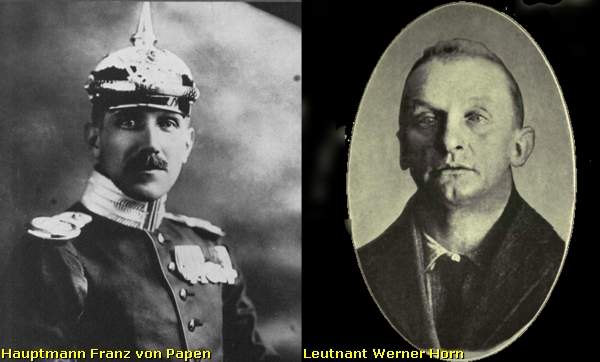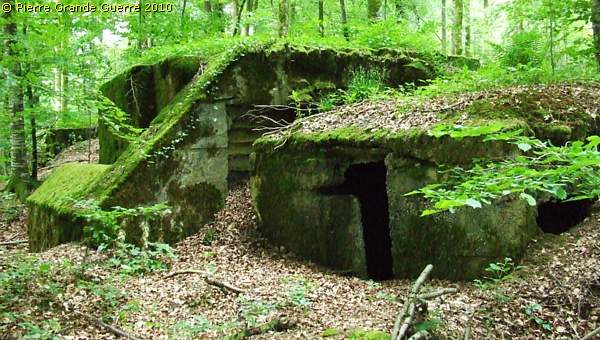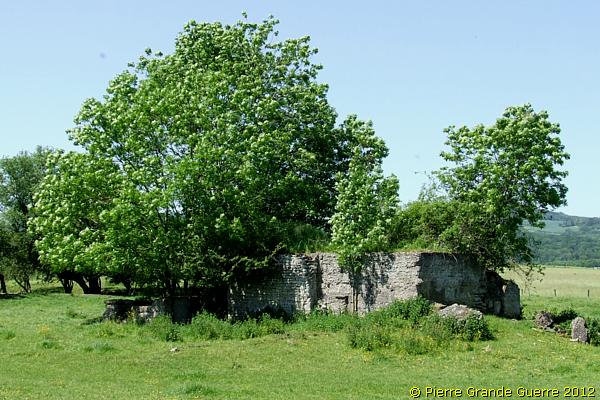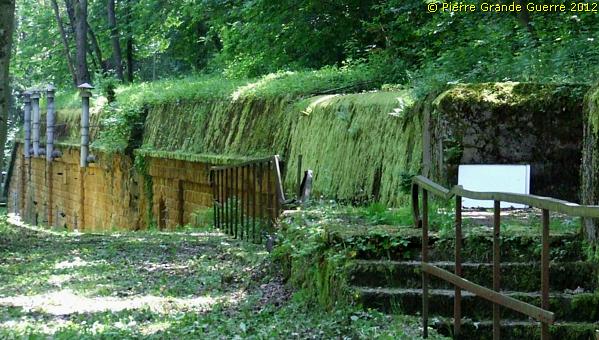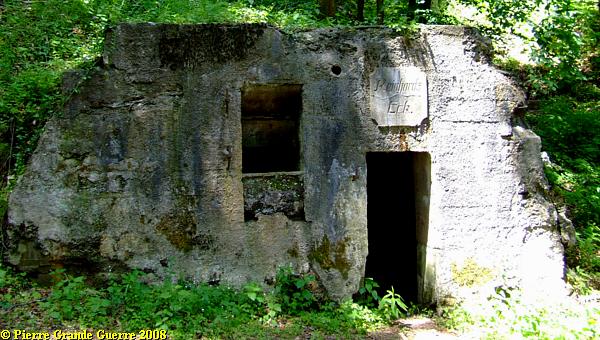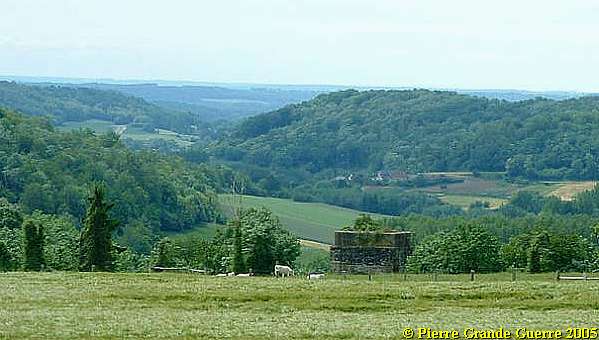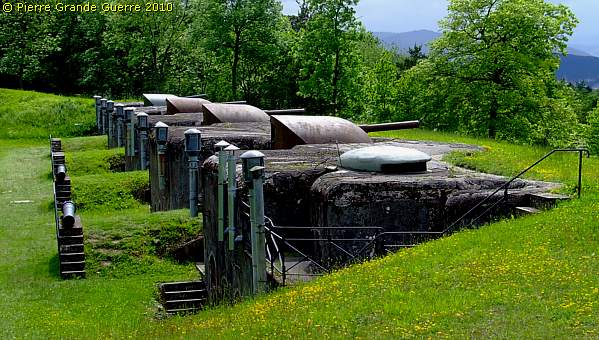VOSGES - Bertrimoutier - Frapelle
Year of visit: 2011

From the Tête de Violu, or the Haute de Faîte, or from the Col de Ste. Marie, we continue via the D 459 north-eastward. We drive “behind the French lines”, via Wisembach and Bonipaire, to stop south of Bertrimoutier to visit the Franco-German War Cemetery. In a frame I will explain the events during the Battle of the Spitzemberg.
After this visit to the cemetery we will cross the former Front Line to continue to Frapelle, where we will visit the Memorial of the U.S. 5th Division at Frapelle. In a frame I will explain the role of the 5th Division in June - August 1918 at Frapelle.

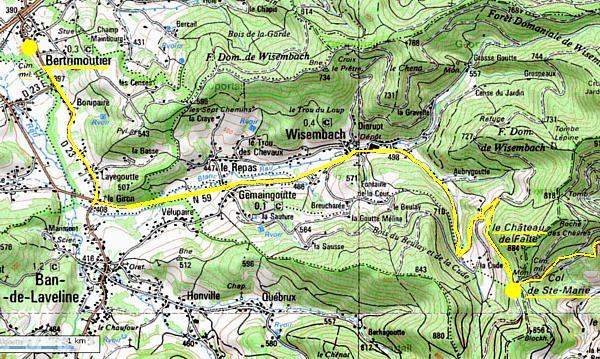
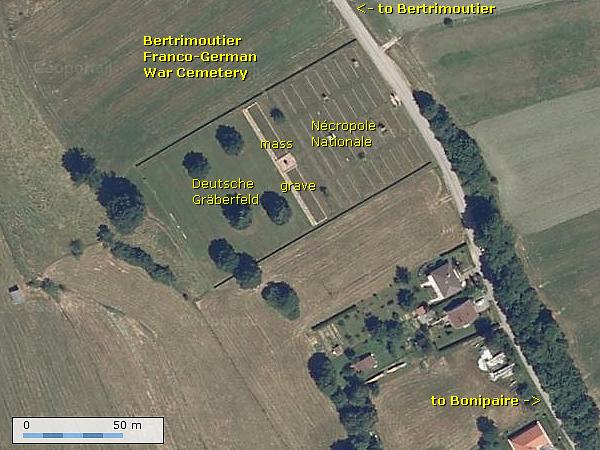
Along a narrow country road between Bonipaire and Bertrimoutier, ...

... at the southern outskirts of the village of Bertrimoutier, lies the Bertrimoutier Franco-German War Cemetery . We enter both cemeteries, French and German, via the entrance to the French cemetery.
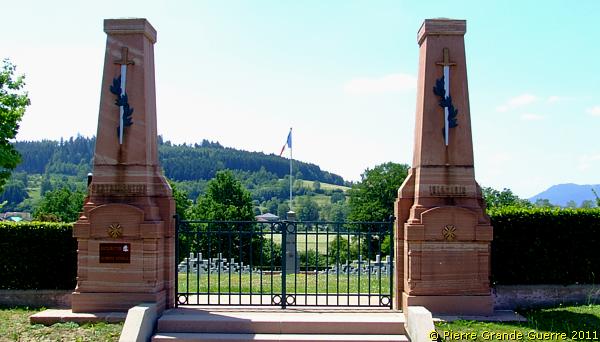
Bertrimoutier Nécropole Nationale
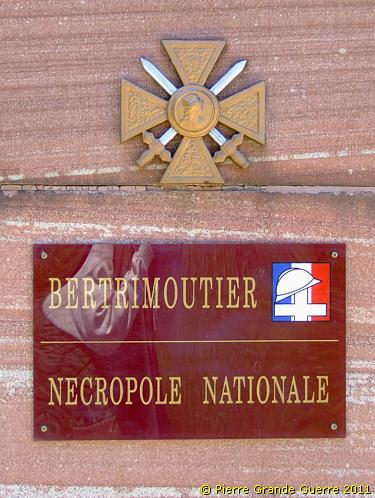
The Bertrimoutier Franco-German War Cemetery was created in March 1921 by the French military authorities as a collective cemetery.
The Bertrimoutier Nécropole Nationale contains 966 graves. 953 Graves contain French officers and soldiers, including 4 Indo-Chinese soldiers. There is a communal grave containing 12 Russian soldiers and and there is one grave containing a Romanian soldier. There is no mass grave.
The officers and soldiers, buried here, were killed during all periods of the war, at the slopes of the Chaume de Lusse , east from here, of the Tête de Violu , (south-west), of the Dansant de la Fète (north), at Frapelle, and in the region of the Spitzemberg and Ban de Sapt (north-west).
The French cemetery oversees the
German cemetery below it.

As always I show you only some of the many graves here. A soldier of the 75e R.I., fallen on 28 August 1914.
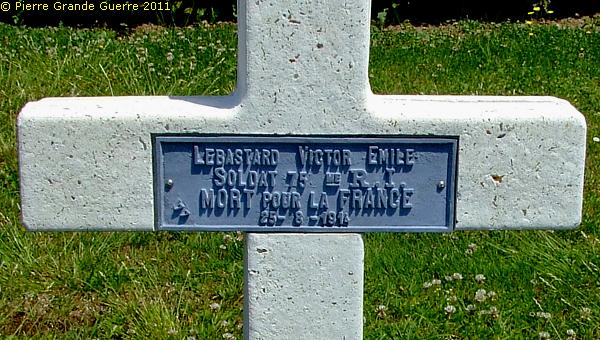
There are many more graves of the period of the period of late August 1914 ...

... and of September 1914. The grave of a Chasseur à Pied.
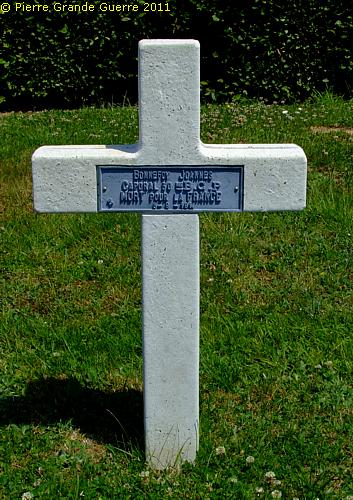
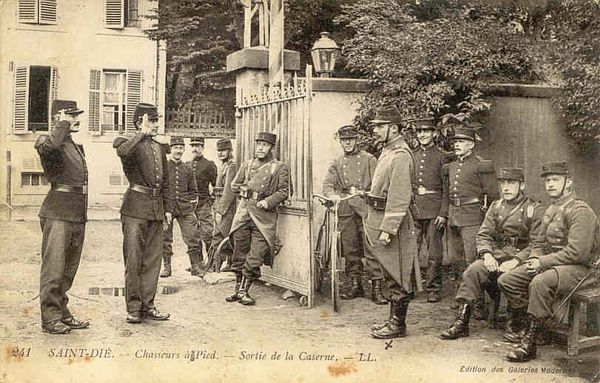
A view north-westward over the cemetery to the Ormont.
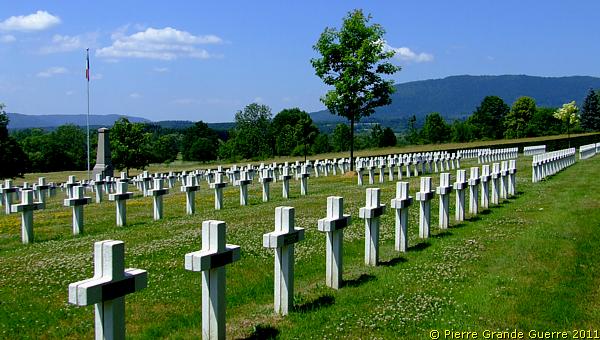
Before we continue we enjoy a north-west view from the edge of the cemetery to the Ormont (left), the Tête de Raves (right), and the Spitzemberg (utter right). The tower on the right is of the village church of Bertrimoutier.
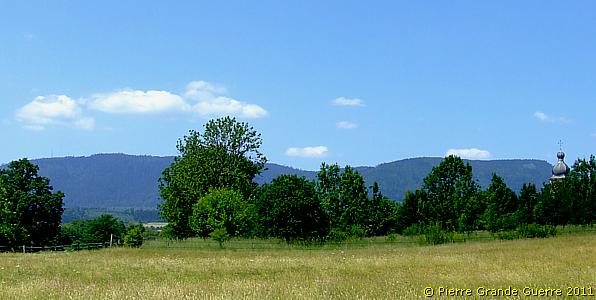
In September 1914 the famous Red Devil Regiment of the 152e R.I. was fighting to capture the summit of the Spitzemberg in the north.
Pierre Deboisse was a victim of the German counterattacks, which followed after the capture of the mountain.
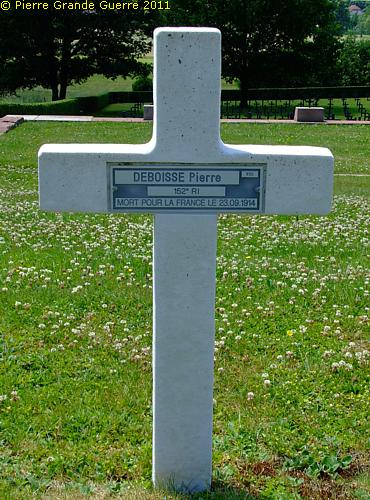
The 152e Régiment d'Infanterie at Bertrimoutiers and the Spitzemberg
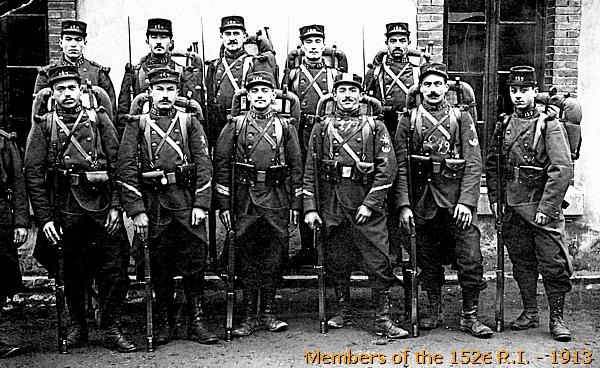
24 August 1914 - German attacks on St. Dié des Vosges
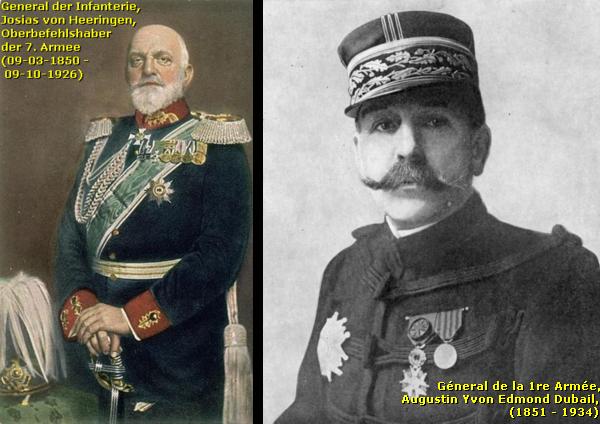
On 24 August General Von
Heeringen's 7th Army launched the Battle of the Haute Meurthe -
Mortange, sometimes also called the Battle of the Vosges, at three
mountain passes in the Northern Vosges, on the left flank of General
Dubail's 1st Army.
These passes were important
roads to the west for the advancing Germans. Von Heeringen's plan was
to conquer the nearby city of
Saint Dié des Vosges
!
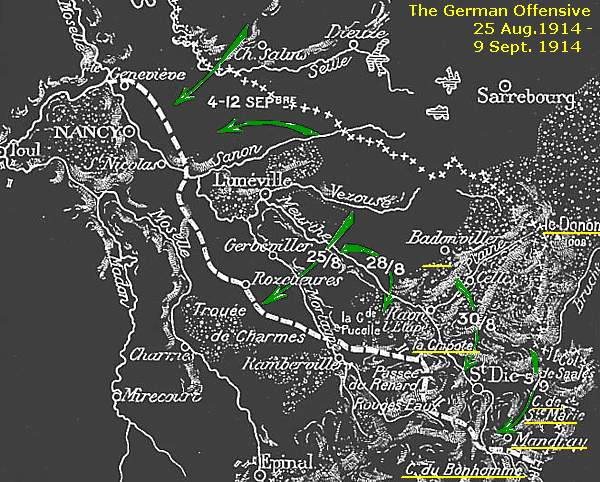
General Von Heeringen's 7th Army attacked on 24 August successfully the pass of the Col du Donon. On the 26th the Germans attacked the Col de la Chapelotte . The French were forced to withdraw. Between 24 August and 5 September the Germans tried to conquer the Col de la Chipotte . In the east the Germans attacked from Saales and the Chipotte southward the Col de Mandray , the Col des Journaux , and the Col de Ste. Marie .
From this period, 26 -29 August 1914, you will find many graves, German and French, in this Bertrimoutier cemetery!
28 August 1914 - The creation of the "Groupement des Vosges"
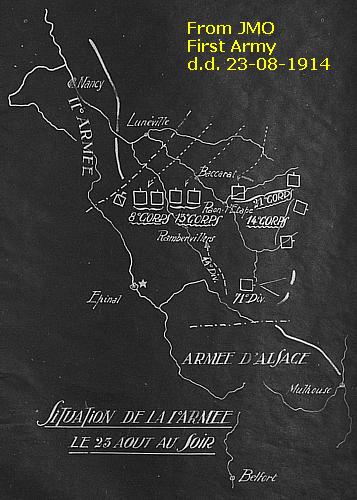
Though the Alsace Army was at first rather successful in the Alsace Sundgau , the fighting in Alsace Lorraine and the Northern Vosges did not develop at all according to the French plans for the 1st Army and 2nd Army.
On 27 August, the Germans even reached from the north the Col du Bonhomme and more to the west, on the 29th the Col des Journaux and the Col de Mandray, being the northern outskirts of the villages of Anould and Fraize, south of Bertrimoutier.
These events forced Joffre to
dissolve his First Army and to reorganise it thoroughly, together with
the Alsace Army ("l'Armée d'Alsace"). Joffre renamed the new
army group on 28 August 1914 at 14.00 hrs the " Groupement des
Vosges
", the Vosges (Army) Group.
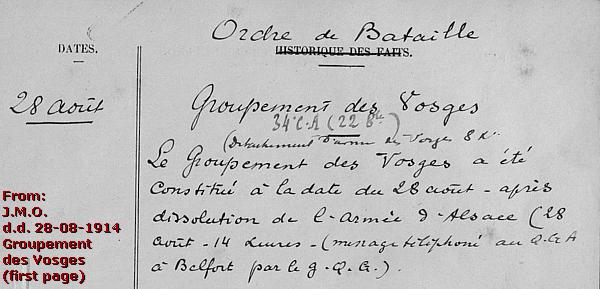
30 August 1914 - Start Of French Counterattacks
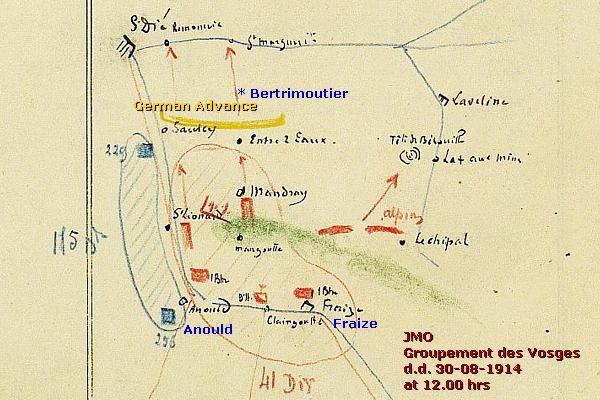
From 29 and 30 August the Groupement des Vosges launched several counterattacks. These forced von Heeringen's Army back to the eastern slopes of the Col de la Chapelotte around 9 September. Von Heeringen retreated to the new frontline, west of Saales. This frontline would stay in a stalemate situation from December 1914 until 1918.
In this region, directly south of Bertrimoutier and Frapelle, the units of the 41e D.I. started to attack the Col de Mandray at 12.00 hrs. and reached at 19.00 hrs. a line south of Bonipaire and Bertrimoutier.
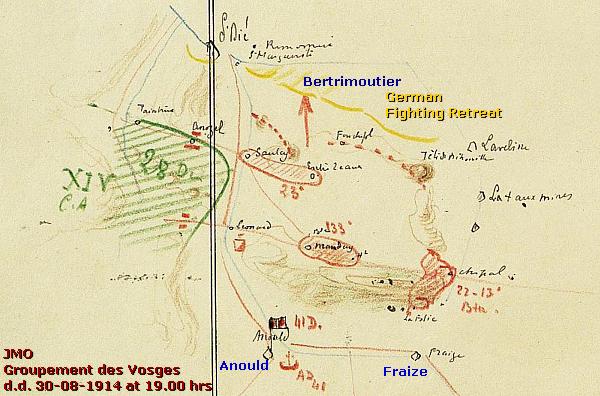
15 September - The 152e R.I. occupies Bertrimoutier
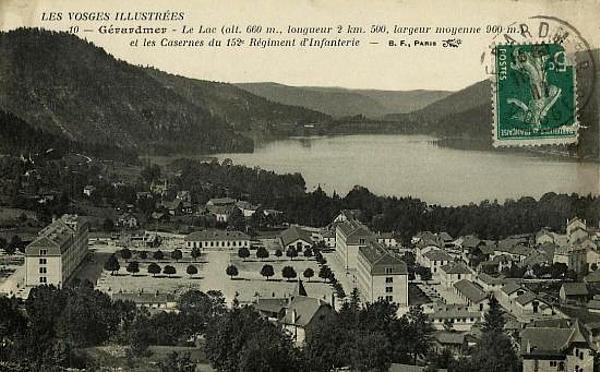
From their garrison in the "Caserne Kléber" in Gérardmer the "Red Devils" fought already in August 1914 at Wintzenheim, west of Colmar , at Soultzeren , near the Col de la Schlucht , and at the Grand Honack .
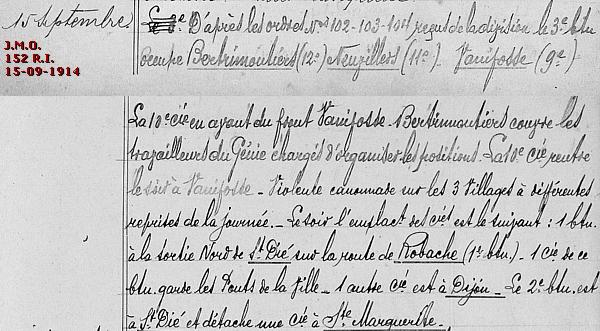
On 14 September 1914 the 152e R.I. received orders to occupy the villages of Neuviller and Bertrimoutier. They achieved this the next day.
From around 17 September Bertimoutier was defended by units of the 66e D.I. Frapelle, Neuvillers and the Spitzemberg were defended by units of the 41e D.I., especially the 152e R.I. and the 46e Bataillon Chasseurs Alpins.
17-20 September 1914 - The Battle of the Spitzemberg
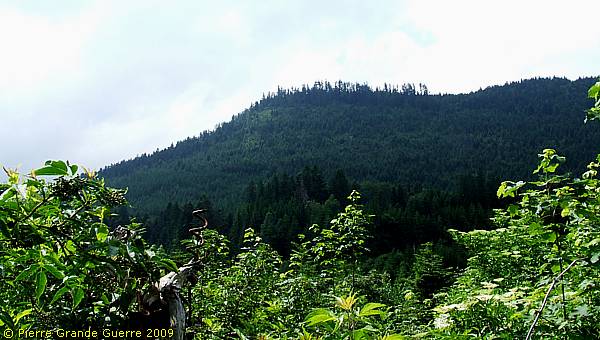
On 17 September 1914, the 152e R.I., supported by the 46e B.C.A., started an attack from their trenches near the hamlets of Charémont and Petit-Charémont, west of Frapelle, to conquer the summit of the nearby Spitzemberg, north-west of Frapelle. The Germans defended stubbornly. The hard battle for the Spitzemberg lasted four days.

After four days of intensive combat and with heavy losses of 8 officers and 600 soldiers the 152e R.I. gained the summit on 20 September 1914. The troops started immediately to consolidate and to fortify their still disputed positions.
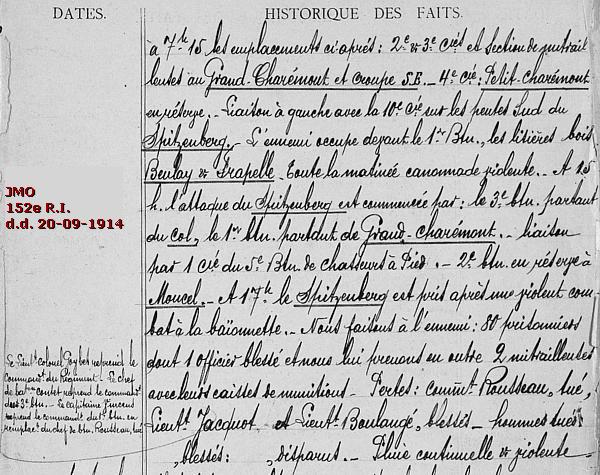
The 152e R.I. and the 46e B.C.A. would be stationed at the Spitzemberg until December 1914, and during this time these units resisted several heavy German counterattacks. The Spitzemberg itself would stay in French possession until the end of the war. The villages of Neuviller (41e D.I.) and Bertrimoutier (66e. D.I.) would also stay in French hands. Frapelle would stay in German possession until 18 August 1918.
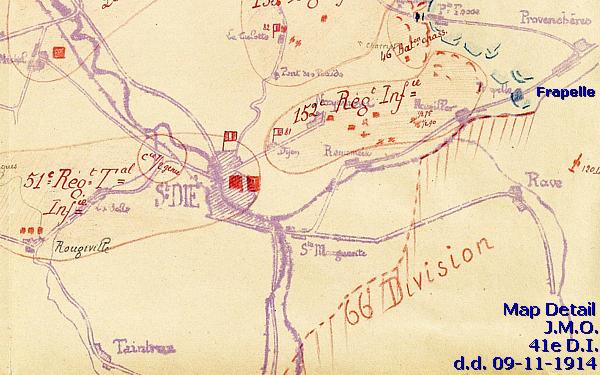
"Les Quinze-Deux", the "Fifteen-Two's", as the soldiers of the 152e R.I. are also nicknamed, have been honoured with a memorial on the summit of the Spitzemberg, which we still have to visit ourselves, alas.
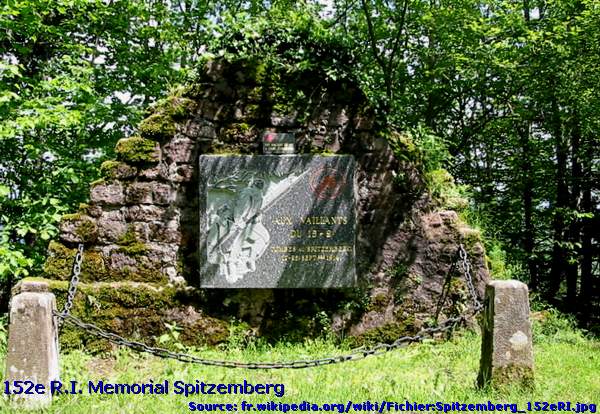
There are also other 152e R.I. memorials to be found in the Vosges; at the Grand Honack , at the Hartmannswillerkopf , and a modern one on the roundabout in front of the current barracks of the 152e R.I. in Colmar.
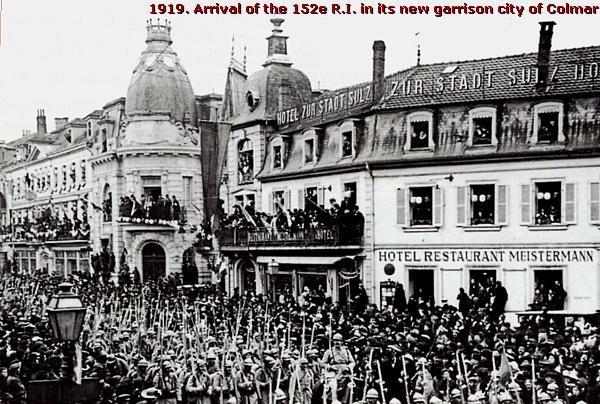
We will now return for some moments to our own modern times and we continue our visit of the cemetery.
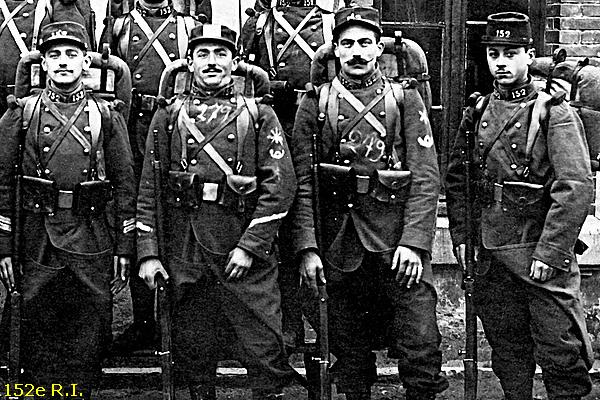
Of course there are also many graves of later periods of the war.
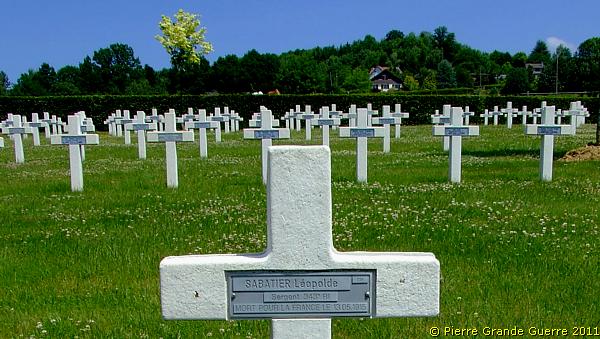
As in every war cemetery, you will also find here graves of unknown soldiers.
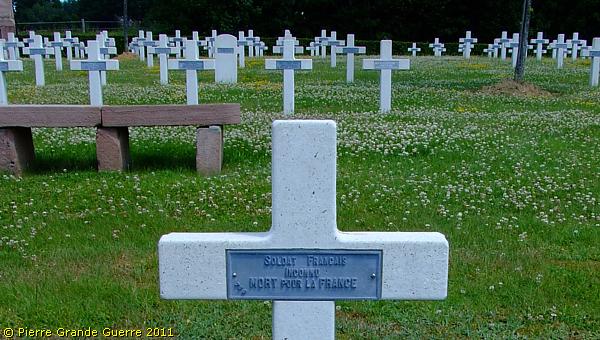

The four graves of Indo-Chinese soldiers.
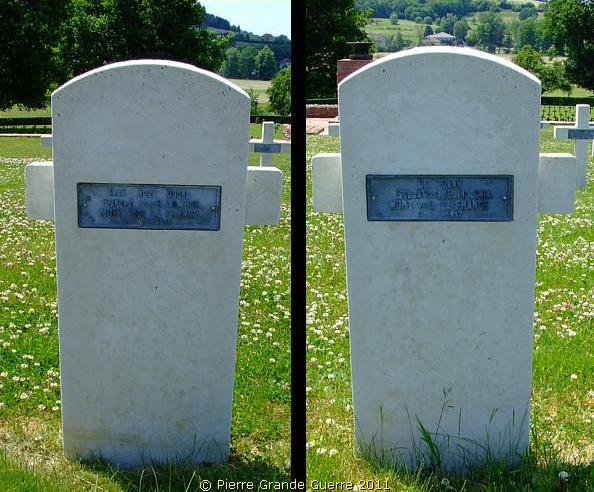
Indo-Chinese soldiers
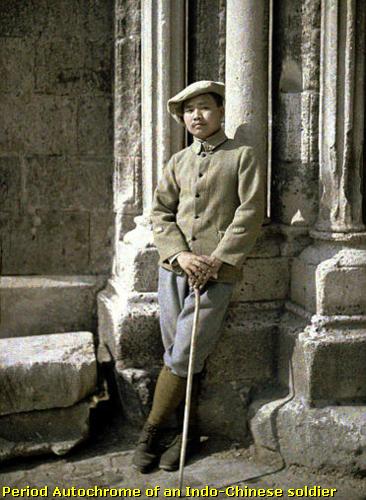
The presence of these four graves of these Indo-Chinese soldiers emphasizes for me, yet again, the worldwide character of the Great War.
These soldiers came to the Western Front from the French protectorate of Indo-China, which comprised the modern Asian states of Cambodia, Laos and Vietnam.
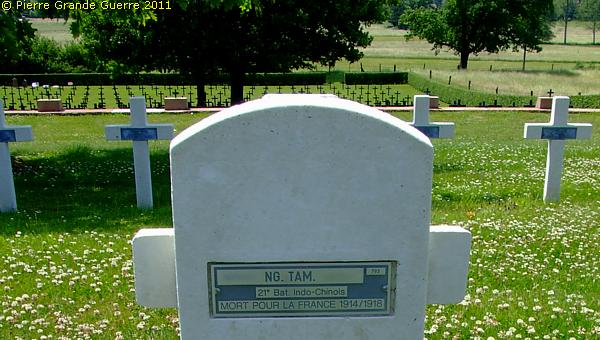
The grave of Biu Van Tao tells us that the 21e Bataillon Indo-Chinois was also called the 21me Bataillon Anamites ( After Annam, Anam or Annan, for Vietnam ).
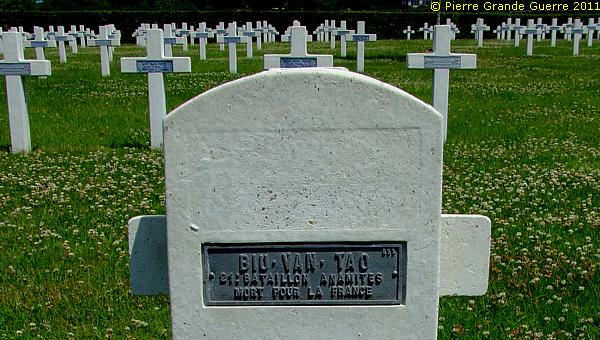
The grave of the unknown Romanian soldier.
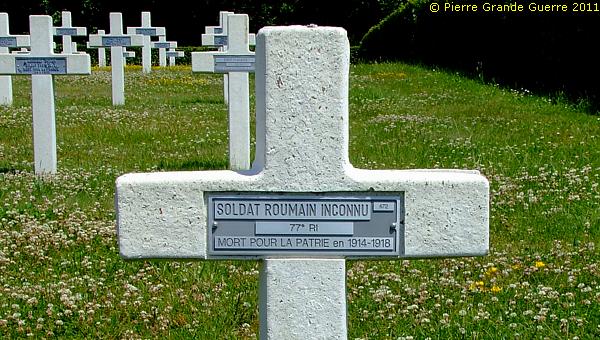
The communal grave of 12 unknown Russian soldiers.

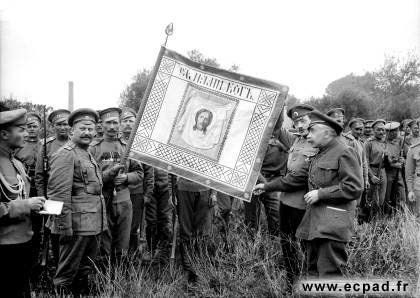
For an explanation about the presence of Russian troops on the Western Front, visit my Champagne Photo Impression about St. Hilaire-le-Grand and its Russian War Cemetery.
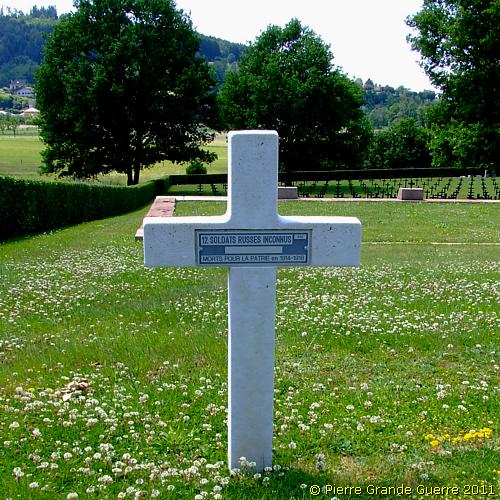
A view north-eastward.
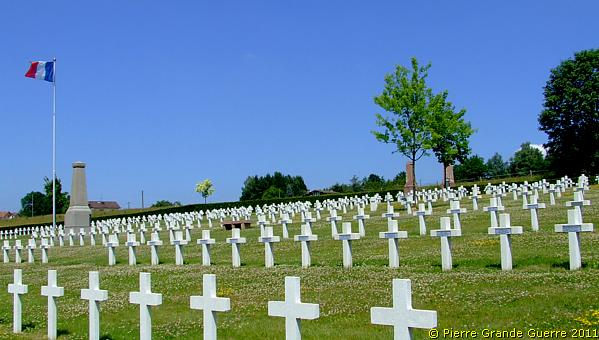
We step over from the French part to the German Cemetery.

The Bavarian 39th Reserve Division - Landwehr Infanterie Regiment 81
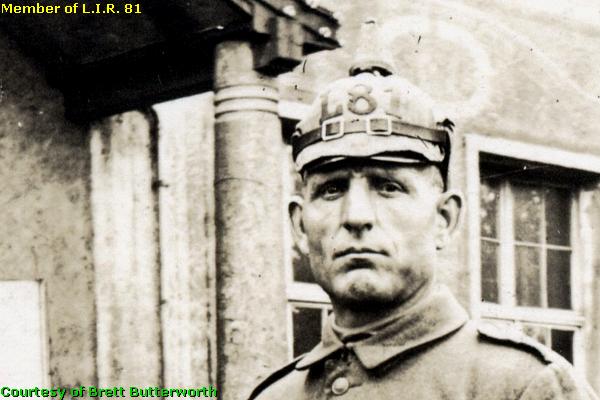
The Bavarian 39th Reserve Division controlled the area northward from Frapelles / Beulay to the valley of the Hure river and the valley of the Fave river, with trenches and bunkers.
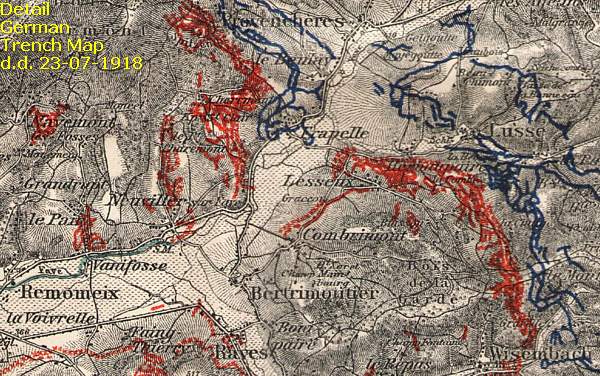
The nearby Col d' Hermanpaire and the eastern half of the Spitzemberg was the territory of the Bavarian 39th Reserve Division and in particular this unit:
Landwehr Infanterie Regiment 81

Their French opponents were various units of the 41e Division d'Infanterie.

Together with the Bavarian 30th Reserve Division, in the north around Ban de Sapt , the 39th formed the army corps of General Magnus von Eberhardt, "Armee Korps Eberhardt".
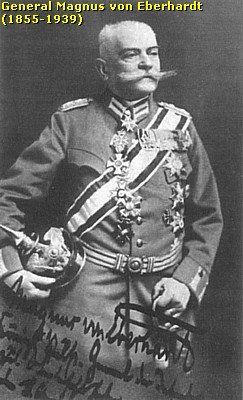
For more background information about historical events in this front sector read my information below on Frapelle. Afterwards continue, please, to the next photo impression about Beulay, the Col d'Hermanpaire , and Ban de Sapt - La Fontenelle .
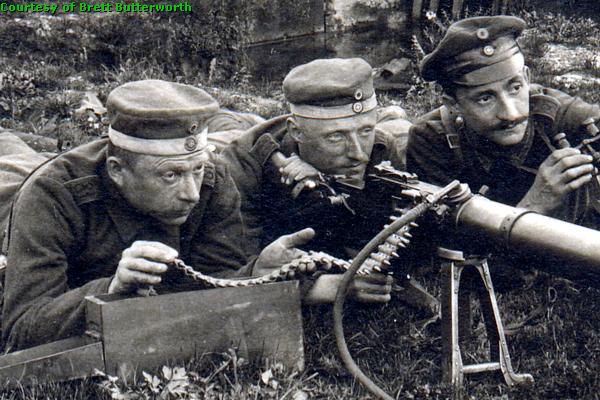
(Period photos in this frame: Courtesy of Brett Butterworth, Australia, of “ Drake Goodman’s Photostream ”.)
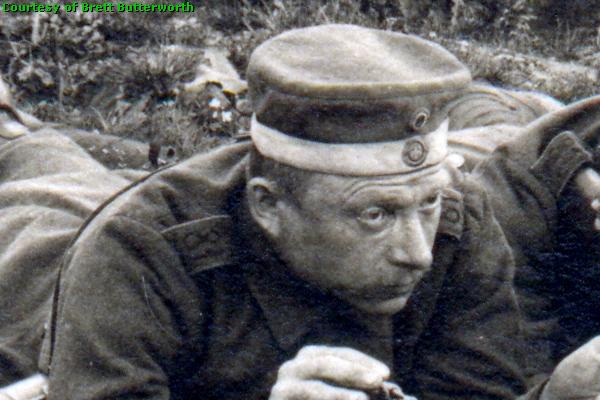
We enter the Bertrimoutier Deutsche Gräberfeld , passing a sober memorial.


Bertrimoutier Gräberfeld
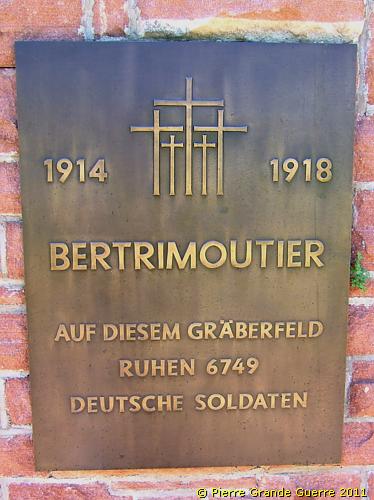
The German War Cemetery or the Bertrimoutier Gräberfeld
contains the graves of 6.749 officers and soldiers. Only about a third of those soldiers, buried here, are known by name. 1.243 officers and soldiers rest in individual graves. 53 soldiers are unknown. 5.506 Men are buried in the two large communal graves. The names of 4.080 officers and soldiers remain unknown.
Most of these soldiers were at first buried elsewhere; their graves were scattered in a radius of up to 40 kilometres in 26 different municipal areas. The majority lost their lives during the period August - December 1914. The others were killed during the trench warfare period of 1915-1918. The soldiers belonged to units mainly from Bavaria, but also from Baden, Württemberg, Hesse, Saxony, Brandenburg and the Rhineland.
Again the satellite view as reminder of the local situation.

View south-westward over the left plot of the German cemetery.

View north-westward over the right plot.
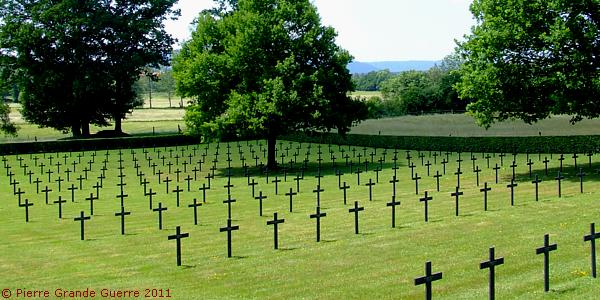
| Left: the southern communal grave. |
Right: the northern communal grave. |
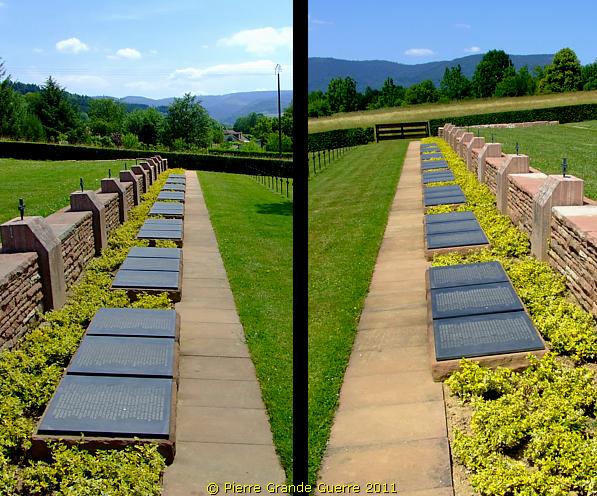
5.506 Officers and soldiers are buried in these two large communal graves. The names of 4.080 men remain unknown.

Inscriptions of names on every column.
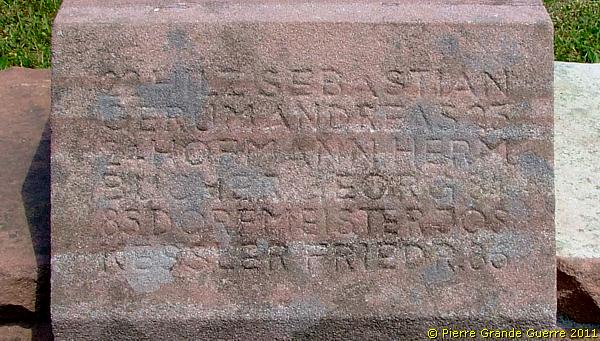
Bronze plates with almost endless lists of names ...

... of fallen officers and soldiers: name, rank, and date of death.
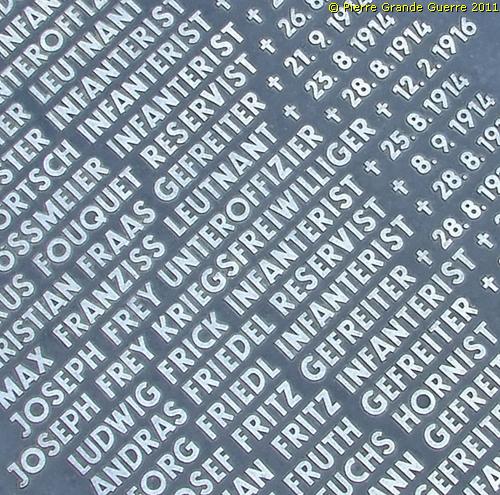
A modest sign, presumably put here recently by relatives:
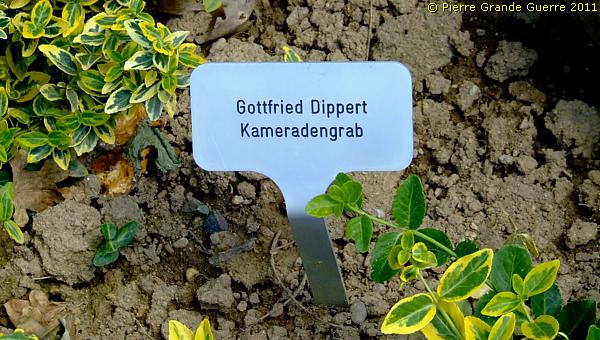
From the communal graves we go slowly downward to the edge of the cemetery.
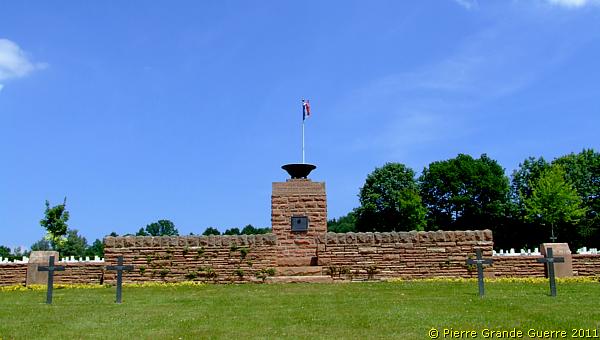
View from the south-west edge upward the cemetery. Even the design of this location, with the French graves and flag on top, the German graves below, seems to emphasize, who did win this Great War.

Along the hedge we find a row of some early war period head stones.

We have a closer look at these headstones.
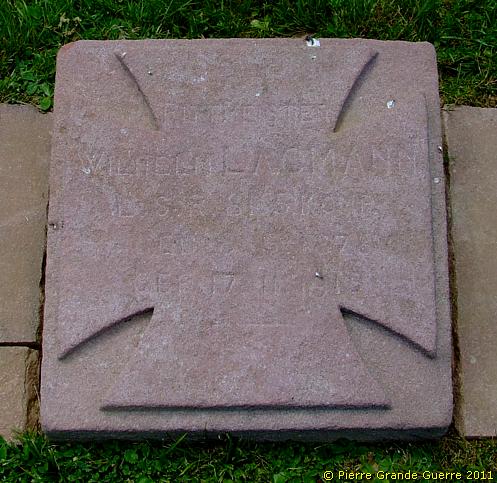
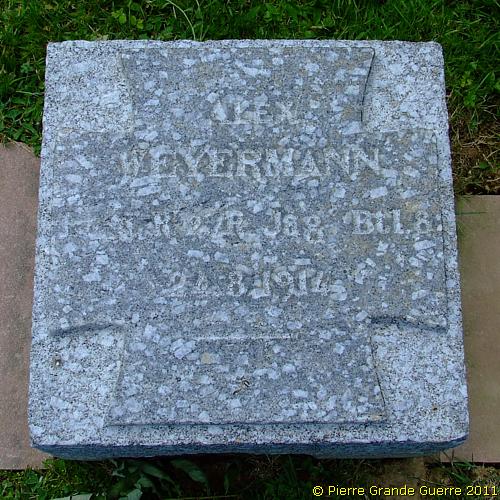
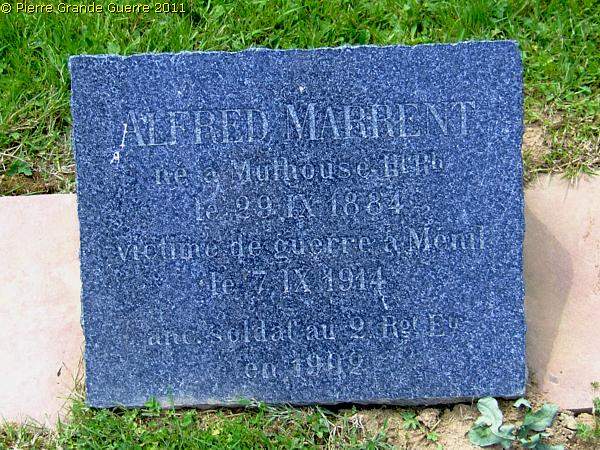
The grave of a Staff Sergeant;

The majority of these headstones commemorate men of L.I.R. 81 . Some head stones bear interesting inscriptions.
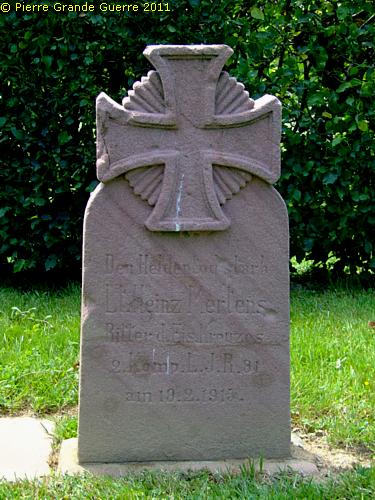

Another grave of a 2nd. Lieutenant of L.I.R. 81 tells us:

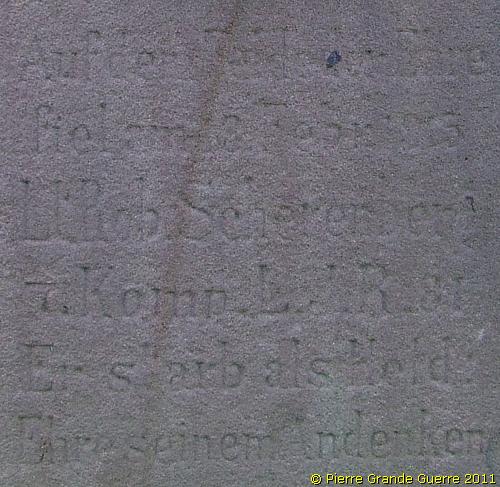

The grave of a Landwehrmann, an infantryman.
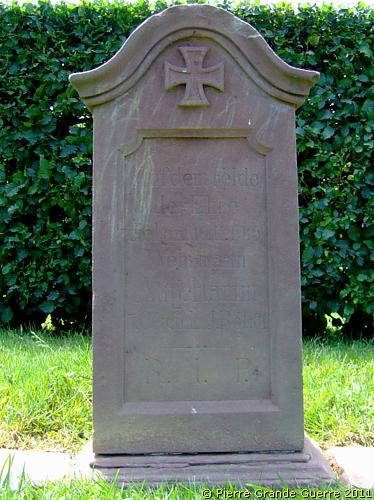
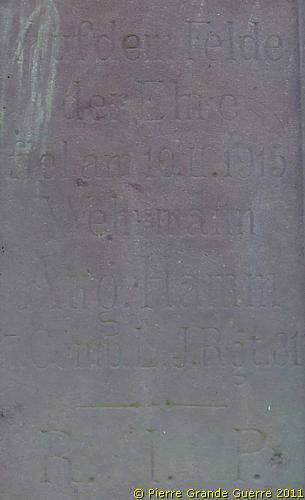
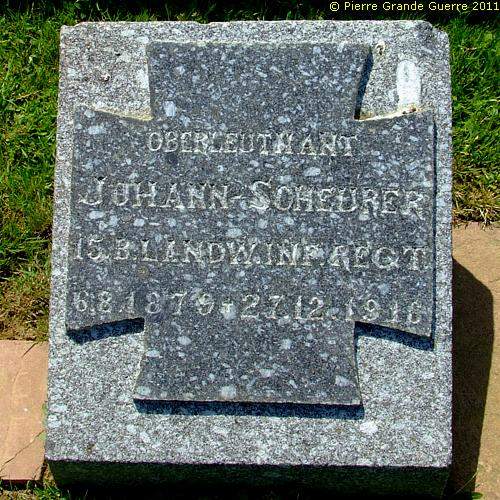
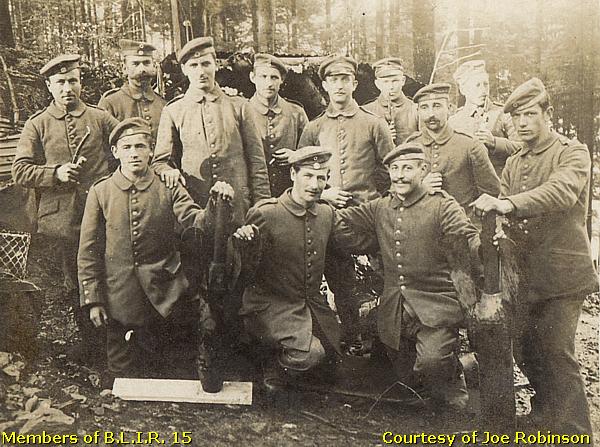

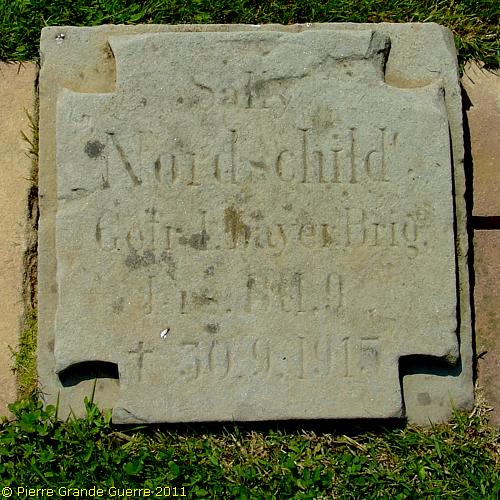
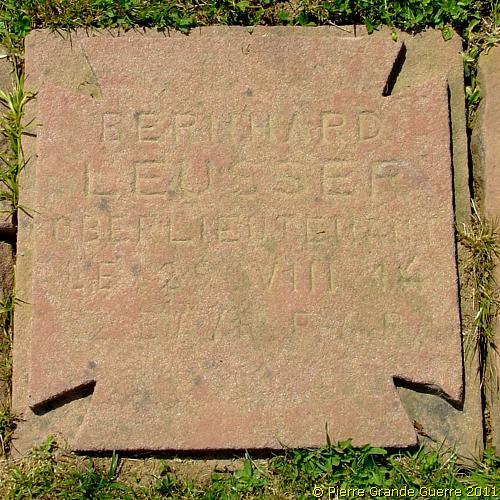
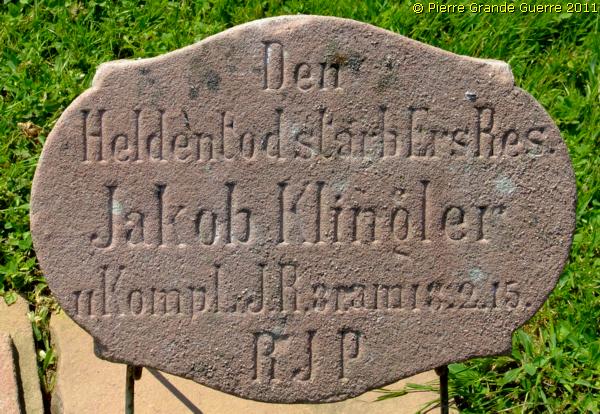
Of course we also made a tour along the steel crosses...
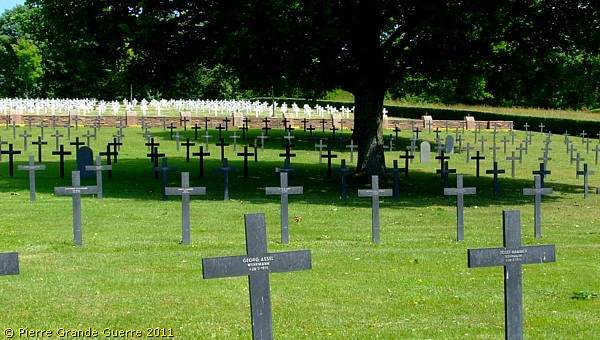
... and some Jewish headstones.

Steel crosses with names of all ranks. A War Volunteer.

A Lance Corporal.

A Staff Sergeant. Graves of the period 26-29 August 1914.

A Lieutenant.

A Captain.


We ascend the hill ...

... to leave the cemetery, ...

...
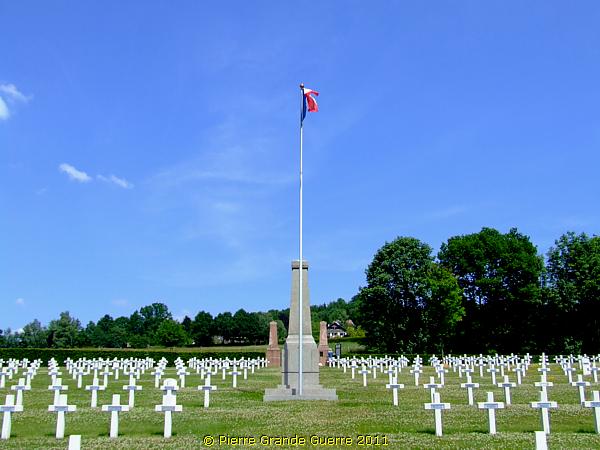
... to continue some 3,5 km. northward to Frapelle, crossing the former front line at a location called, Croix de Vraipaire.
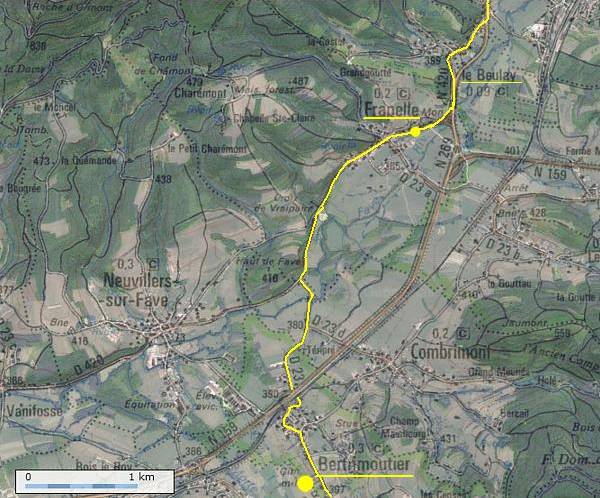
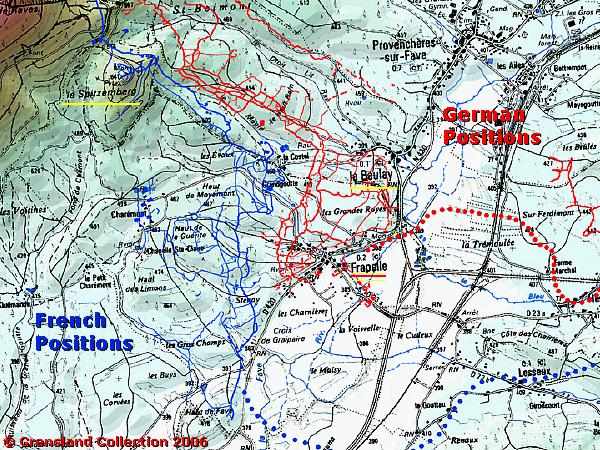
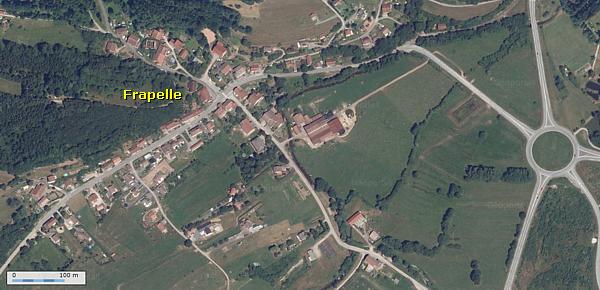
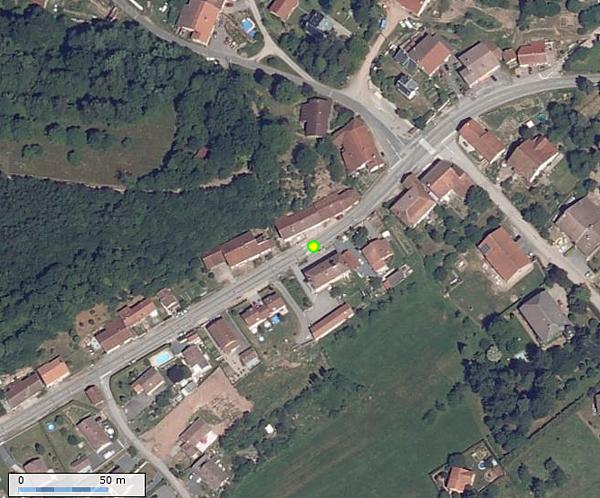
In the nowadays ordinary, sleepy village of Frapelle ...
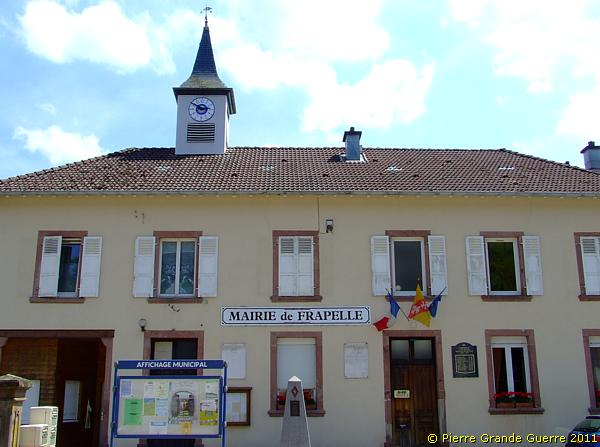
... we visit the Mairie, the Community Hall, for its memorials.
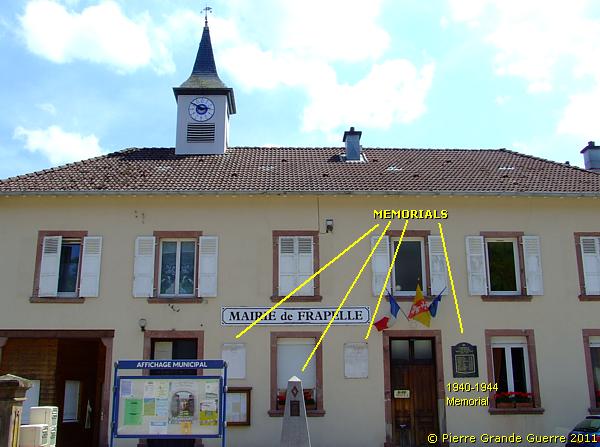
In a nutshell these memorials tell the history of the village.

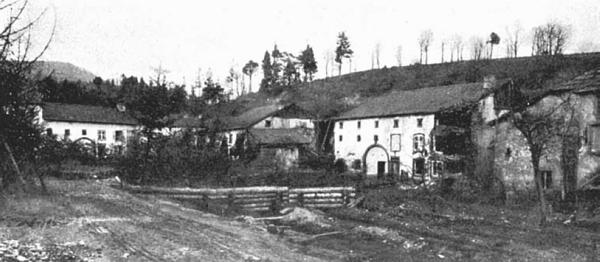
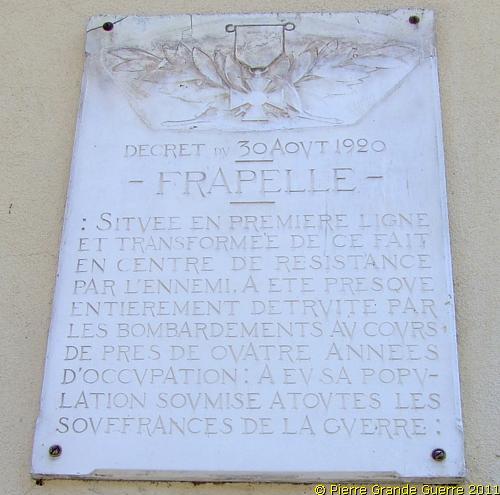
In front of the Mairie stands this modest post war demarcation obelisk, marked with a red diamond.
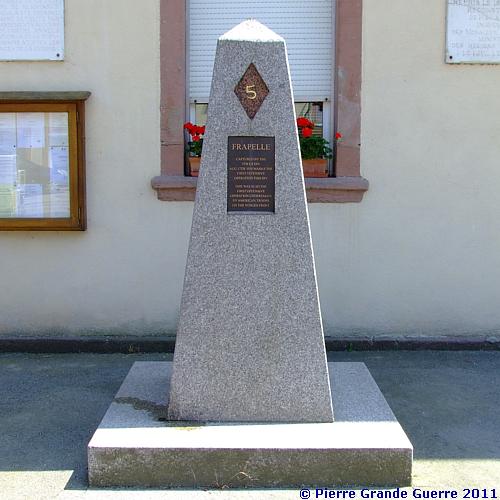
This U.S. 5th Division Memorial tells us:
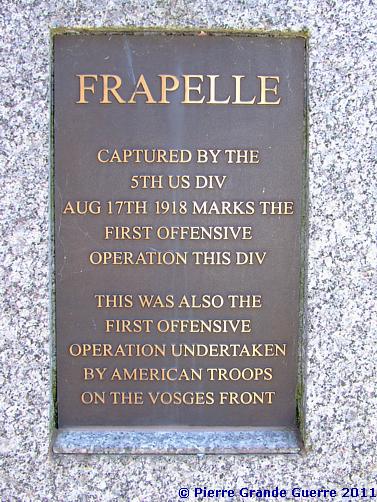
In the frame below I will explain some background to this memorial text.
The U.S. 5th Division at Frapelle
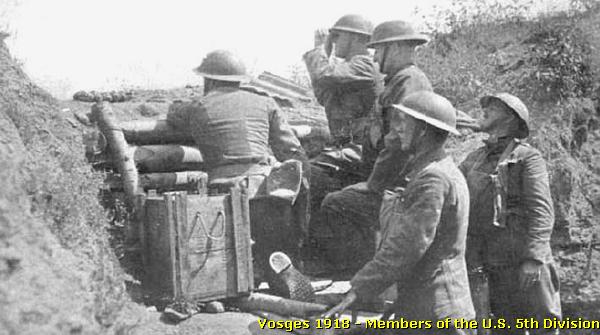
The 5th Division, commanded by Major General John E. McMahon, arrived in France in May 1918. Its principal units were: the 9th Brigade commanded by Brig. Gen. Castner with the 60th and 61st Infantry Regiments, the 10th Brigade commanded by Brig. Gen. Gordon with the 6th and 11th I.R.’s, the 5th Field Artillery Brigade commanded by Brig. Gen. Flagler with the 19th, 20th and 21 F.A.R’s, next the 13th, 14th and 15th Machine-gun Battalions, the 7th Engineers and the 5th Sanitary Train.
During their training period at Bar-sur-Aube the 5th Division “received an unusually thorough and continuous gas training.”
15 June 1918 - The Anould Sector
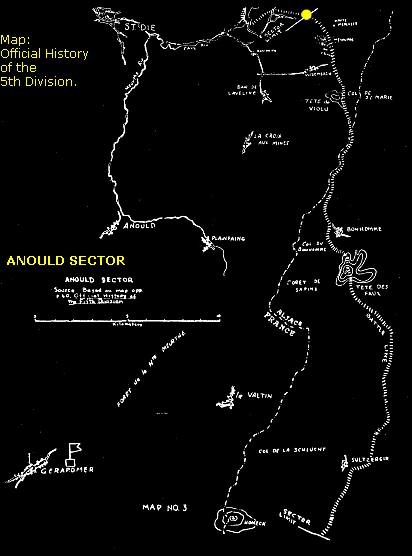
On 1 June 1918, the 5th Division was assigned to the French General le Conte’s XXXIII Army Corps of the 7th Army. Between 15 June and 23 June units of the 5th Division together with the French 21e D.I. relieved the 70e D.I. in the Anould sector. The Anould sector spanned 30 kilometres, from Bertrimoutier in the north until the Honeck mountain in the south. The troops received here further trench warfare training by experienced French Territorials. The Germans had transformed the village of Frapelle into a triangular shaped salient.
17 June 1918 - First Gas Attack
Experience
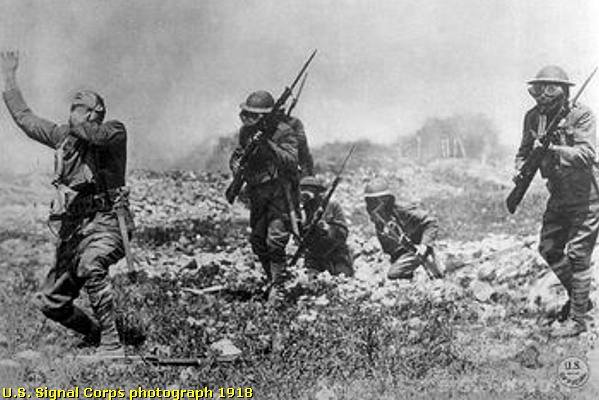
On 17 June the troops of the 5th Division got their first gas attack experience near Bertrimoutiers and Frapelle, which was not directed at the new troops, but the “customary preparation for one of the enemy raids made periodically on this front”.
A few days before, on the 13th, the Bavarian Ersatz Regiment 5 of the 39. Reserve Division was reinforced by the Pioniere Bataillon 38. The Pioneers installed 1,183 Minenwerf gas projectors on the heights of the Chaume de Lusse and the Dansant de la Fète (German: Tanzwald), mainly loaded with “green cross” phosgene shells. At 2.50 hrs. they discharged 923 gas projectors and 106 high explosives Minenwerfer to support the following six raiding parties, the first led by two companies.
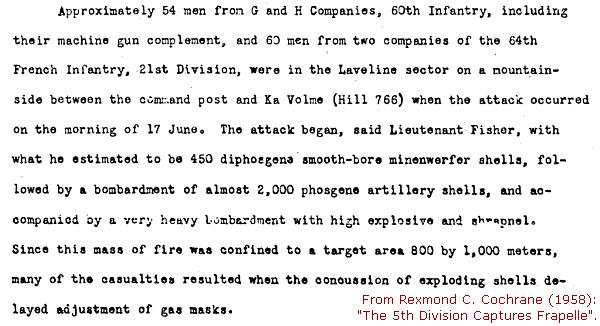
In the two weeks that followed until 27 June, the Germans continued their gas attacks, firing 9.869 small, medium and large calibre shells. The U.S. troops counted 13 men killed, 17 wounded and 27 men gassed, mainly by "delayed adjustment of gas masks". After 27 June the sector temporarily became quiet again.
15 July 1918 - The Saint Dié Sector
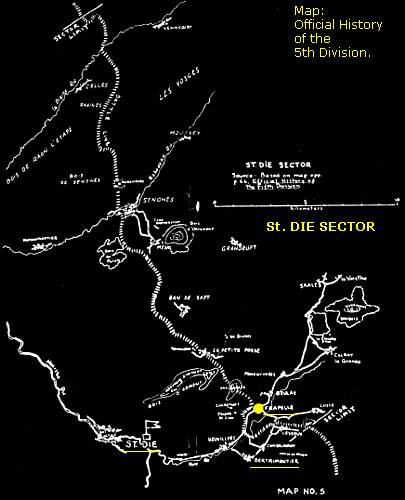
On 15 July the 9th and 10th Brigade moved to the north, to the adjacent St. Dié sector, which stretched from the Chapelotte in the north, overlapping the Frapelle sector, until the Col de Ste. Marie in the south.
4-16 August 1918
During the period of 4-16 August both sides exchanged artillery fire almost continuously. The Germans fired approximately 3,000 high explosives rounds, the Americans fired 2,341 rounds.
17 August 1918 - The U.S. 5th
Division attacks Frapelle
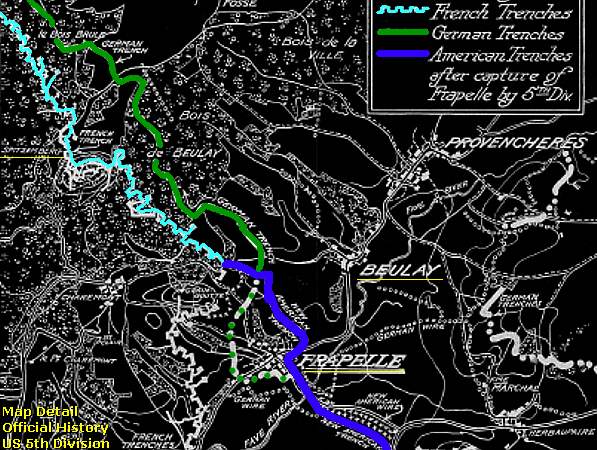
On 17 August, at 03.45 hrs. 34 artillery batteries launched a six minutes preliminary bombardment on the German positions at Frapelle and Hill 451, north of Frapelle. At 04.00 hrs. the artillery fire lifted and the 13th Machine-gun Battalion laid a barrage on the exits and the streets of Frapelle.
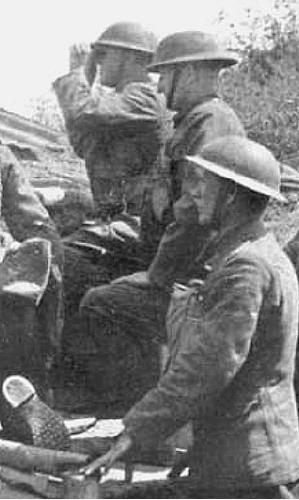
The L and M companies of the 3rd Batt. of the 6th I.R. climbed out of their trenches near Charémont and attacked the village. Behind them followed A and C companies as support, and I and K filled the vacated trenches.
Only five minutes later the Germans began a counter barrage on the 2nd and 3rd wave of the attack and the captured trenches. Ahead of this counter barrage company L took Frapelle and company M, overcoming machine-gun fire from its slope, occupied Hill 451.
The operation seemed over by 04.45 hrs. But the occupation of the village was to prove more costly!
While the soldiers were consolidating their new positions, at 10 O’clock, the Germans launched from Beulay an artillery bombardment. At 14.00 hrs gas shells were falling down on Frapelle. At 16.00 hrs. more high explosives and gas shells came down and the bombardment continued to the evening.
18 August 1918
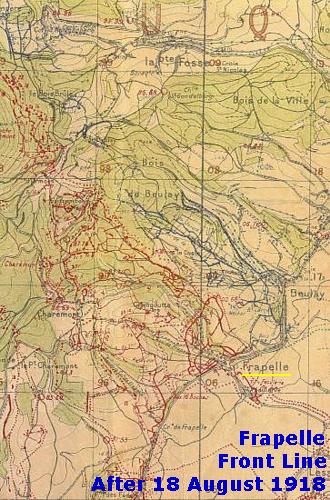
In the early morning of 18 August, between 01.10 hrs. and 07.15 hrs. the Germans resumed and intensified their gas attacks with mustard gas shells. The rest of the morning and the afternoon the bombardment on Frapelles continued with high explosives shells. At 21.00 hrs, the Germans launched their last infantry counterattack at Frapelle, which lasted until 22.30 hrs. and which was after all unsuccessful.
Just before midnight Fapelle was definitely in American possession. The Americans advanced from Charémont about 1.5 kilometres, just to the northern outskirts of Frapelle. They did not reach the Bois Carré, south of Beulay nor the village of Beulay. But the salient of Frapelle did not exist by now, and the Americans had shortened the front line.
The U.S. casualties at
Frapelle during the period of 17-21 August 1918
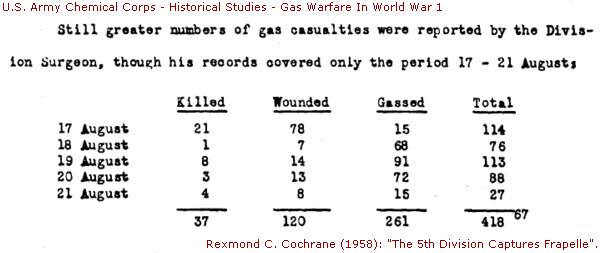
The casualty numbers of the days during the two days of the capture of Frapelle, but in particular the relatively high casualty numbers of the days immediately after the capture of Frapelle show us that the Germans did not accept at all the conquest of their former salient and that they continued shelling Frapelle from Beulay and Lusse with gas and high explosives.
In spite of the emphasis on gas warfare during "an unusually thorough and continuous gas training" at Bar-sur-Aube sixty-two percent of the American casualties were gassed!
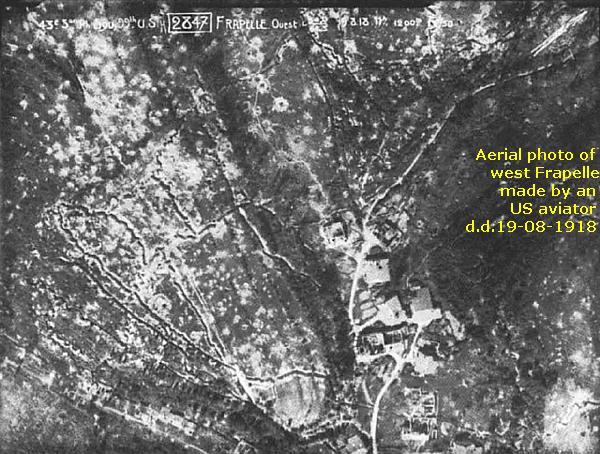
Source:
U.S. Army Chemical
Corps - Historical Studies – Gas Warfare In World War 1 – Rexmond C.
Cochrane (1958): “The 5th Division Captures Frapelle”.
The New York Times of 19 August 1918
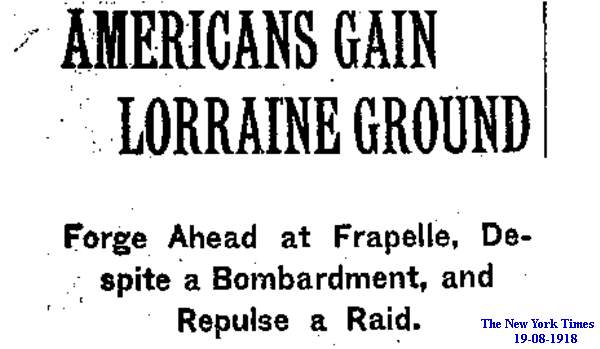
After my dry survey of the events I offer you a more vivid account of the Battle of Frapelle via a newspaper article of the period, of the New York Times of 19 August 1918. For reasons of censorship and propaganda the tone of this article is not critical but of course merely victorious. Although the article mentions the gas attacks, it remains silent about the high gas related casualty numbers. But as a first account of the battle, the report is interesting.
Read news paper clips scrolling down.
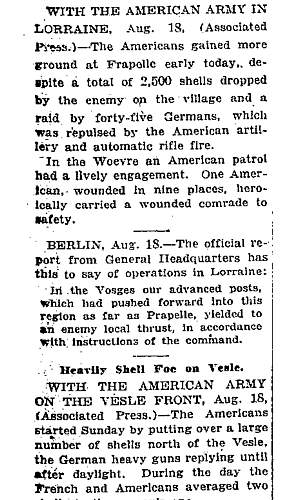
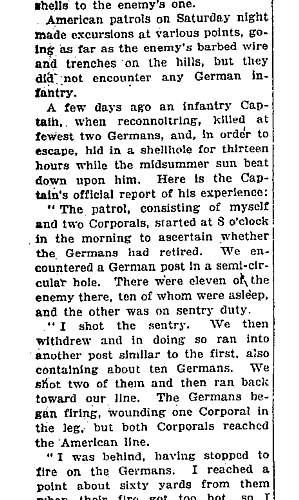
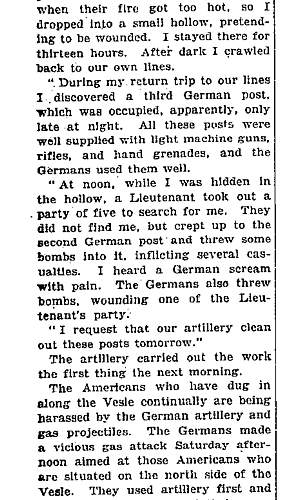
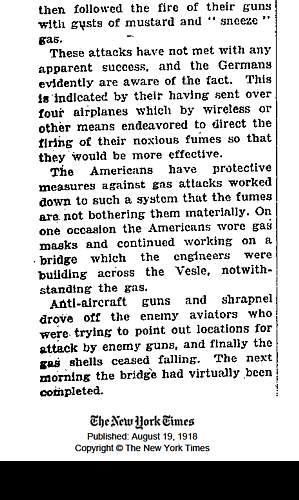
With a last view at the U.S. 5th Division Memorial, ...

.. and a view of the front of the Mairie of Frapelle, ...

... we will follow next the front line northward via Beulay, via the foot of the Spitzemberg at the Col d' Hermanpaire, to Ban de Sapt - La Fontenelle.
Continue to: " Ban de Sapt - La Fontenelle "
